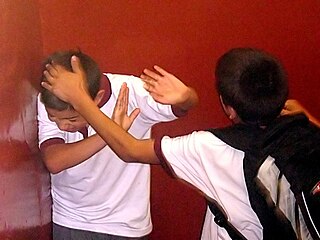Related Research Articles

Developmental psychology is the scientific study of how and why humans grow, change, and adapt across the course of their lives. Originally concerned with infants and children, the field has expanded to include adolescence, adult development, aging, and the entire lifespan. Developmental psychologists aim to explain how thinking, feeling, and behaviors change throughout life. This field examines change across three major dimensions, which are physical development, cognitive development, and social emotional development. Within these three dimensions are a broad range of topics including motor skills, executive functions, moral understanding, language acquisition, social change, personality, emotional development, self-concept, and identity formation.

Conduct disorder (CD) is a mental disorder diagnosed in childhood or adolescence that presents itself through a repetitive and persistent pattern of behavior that includes theft, lies, physical violence that may lead to destruction, and reckless breaking of rules, in which the basic rights of others or major age-appropriate norms are violated. These behaviors are often referred to as "antisocial behaviors", and is often seen as the precursor to antisocial personality disorder; however, the latter, by definition, cannot be diagnosed until the individual is 18 years old. Conduct disorder may result from parental rejection and neglect and can be treated with family therapy, as well as behavioral modifications and pharmacotherapy. Conduct disorder is estimated to affect 51.1 million people globally as of 2013.
Attachment disorder is a broad term intended to describe disorders of mood, behavior, and social relationships arising from unavailability of normal socializing care and attention from primary caregiving figures in early childhood. Such a failure would result from unusual early experiences of neglect, abuse, abrupt separation from caregivers between three months and three years of age, frequent change or excessive numbers of caregivers, or lack of caregiver responsiveness to child communicative efforts resulting in a lack of basic trust. A problematic history of social relationships occurring after about age three may be distressing to a child, but does not result in attachment disorder.
Mary Dinsmore Ainsworth was an American-Canadian developmental psychologist known for her work in the development of the attachment theory. She designed the strange situation procedure to observe early emotional attachment between a child and their primary caregiver.

Attachment in children is "a biological instinct in which proximity to an attachment figure is sought when the child senses or perceives threat or discomfort. Attachment behaviour anticipates a response by the attachment figure which will remove threat or discomfort". Attachment also describes the function of availability, which is the degree to which the authoritative figure is responsive to the child's needs and shares communication with them. Childhood attachment can define characteristics that will shape the child's sense of self, their forms of emotion-regulation, and how they carry out relationships with others. Attachment is found in all mammals to some degree, especially primates.
Attachment measures, or attachment assessments, are the various procedures used to assess the attachment system in children and adults. These procedures can assess patterns of attachment and individual self-protective strategies. Some assessments work across the several models of attachment and some are model-specific. Many assessments allow children and adults' attachment strategies to be classified into three primary attachment pattern groups: B-pattern, A-pattern, C-pattern. In most models, each pattern group is further broken down into several sub-patterns. Some assessments are capable of finding additional information about an individual, such as unresolved trauma, depression, history of family triangulation, and lifespan changes in the attachment pattern. Some assessments specifically or additionally look for caregiving behaviors, as caregiving and attachment are widely considered two separate systems for organizing thoughts, feelings, and behavior. Some methods assess disorders of attachment or romantic attachment.
Developmental psychopathology is the study of the development of psychological disorders with a life course perspective. Researchers who work from this perspective emphasize how psychopathology can be understood as normal development gone awry. Developmental psychopathology focuses on both typical and atypical child development in an effort to identify genetic, environmental, and parenting factors that may influence the longitudinal trajectory of psychological well-being.

John Morton, OBE, FRS is an emeritus professor at the Institute of Cognitive Neuroscience and was the director of the former Medical Research Council (MRC) Cognitive Development Unit (CDU) at University College London.
The differential susceptibility theory proposed by Jay Belsky is another interpretation of psychological findings that are usually discussed according to the diathesis-stress model. Both models suggest that people's development and emotional affect are differentially affected by experiences or qualities of the environment. Where the Diathesis-stress model suggests a group that is sensitive to negative environments only, the differential susceptibility hypothesis suggests a group that is sensitive to both negative and positive environments. A third model, the vantage-sensitivity model, suggests a group that is sensitive to positive environments only. All three models may be considered complementary, and have been combined into a general environmental sensitivity framework.
Mary Main was an American psychologist notable for her work in the field of attachment. A Professor at the University of California Berkeley, Main is particularly known for her introduction of the 'disorganized' infant attachment classification and for development of the Adult Attachment Interview and coding system for assessing states of mind regarding attachment. This work has been described as 'revolutionary' and Main has been described as having 'unprecedented resonance and influence' in the field of psychology.
Patricia McKinsey Crittenden is an American psychologist known for her work in the development of attachment theory and science, her work in the field of developmental psychopathology, and for creation of the Dynamic-Maturational Model of Attachment and Adaptation (DMM).

Dante Cicchetti is an American developmental psychologist and developmental psychopathology scientist specializing in high-risk and disenfranchised populations, including maltreated children and offspring of depressed parents.[1] He holds a joint appointment in the Department of Psychiatry at the University of Minnesota Medical School and in the Institute of Child Development. He is the McKnight Presidential Endowed Chair and the William Harris Endowed Chair.
Sheree Toth is a professor of psychology at the University of Rochester, as well as an associate professor of psychiatry and the executive director of the Mt. Hope Family Center. She works in the field of developmental psychopathology, especially concerning maltreated children.
Heinz Werner's orthogenetic principle is a foundation for current theories of developmental psychology and developmental psychopathology. Initially proposed in 1940, it was formulated in 1957 and states that "wherever development occurs it proceeds from a state of relative globality and lack of differentiation to a state of increasing differentiation, articulation, and hierarchic integration." It is an example of an organismic theory based on the intrinsic activity of living systems and is parallel to Piaget's genetic epistemology both emphasizing a holistic view of development.
Nicki Rae Crick was a psychologist and professor of child development and family studies known internationally for her research on relational aggression, defined as the use of relationships as agents of harm. At the time of her death, she held the position of Distinguished McKnight University Professor and Irving B. Harris Professor of Child Psychology at the Institute of Child Development, University of Minnesota.

Stephen P. Hinshaw is an American psychologist whose contributions lie in the areas of developmental psychopathology and combating the stigma that surrounds mental illness. He has authored more than 325 scientific articles and chapters as well as 14 authored and edited books. Currently, he is Professor in the Department of Psychology at the University of California, Berkeley, and Professor In Residence and Vice Chair for Child and Adolescent Psychology in the Department of Psychiatry at the University of California, San Francisco. His work focuses on child and adolescent mental disorders, clinical interventions, mechanisms of change in psychopathology, and stigma prevention efforts, with a specialization in ADHD and other neurodevelopmental disorders.
Jude Anne Cassidy is Professor of Psychology and Distinguished Scholar-Teacher at the University of Maryland. Cassidy was awarded the American Psychological Association Boyd McCandless Young Scientist Award in 1991 for her early career contributions to Developmental Psychology. She is a Fellow of the American Psychological Association, Division 7 and the Association for Psychological Science.
Norman Garmezy was a professor of psychology who is known for his work in developmental psychopathology. After receiving his Ph.D. from the University of Iowa in 1950, Garmezy held appointments at Duke University (1950–1961) and the Institute of Child Development at the University of Minnesota (1961–1989). His early work was on the etiology of schizophrenia; however, he is best known for his later work on risk, resilience, stress, and coping in child development.
Daniel S. Messinger is an American interdisciplinary developmental psychologist, and academic. His research works span the field of developmental psychology with a focus on emotional and social development of children and infants, and the interactive behavior of children in preschool inclusive classroom.
Raymond A. Knight is a psychologist and academic most known for his research on schizophrenia and on aggressive behavior, particularly sexual aggression, psychopathy, and bullying, exploring their causes, life course, and outcomes, and for developing the Multidimensional Inventory of Development, Sex, and Aggression (MIDSA) that assesses treatment targets for those who have sexually offended. He is a professor emeritus of Human Relations at Brandeis University.
References
- ↑ Shonkoff, J.P., and Meisels, S.J. (2000). Early childhood intervention: A continuing evolution. In J.P. Shonkoff and S.J. Meisels, Handbook of Early Childhood Intervention. New York: Cambridge University Press (p. 11)
- ↑ Kuczinski, L., and Parkin, C.M. (2008). Agency and bidirectionality in socialization: Interactions, transactions, and relational dialectics. In J.E. Grusec, and P.D. Hastings, Handbook of Socialization: Theory and Research (p. 269). New York: Guilford Press.
- ↑ Cicchetti, D. (1989). Developmental psychopathology: Past, present, and future. In D.Cicchetti, (Ed.), The emergence of a discipline: Rochester Symposium on Developmental Psychology. Hillsdale, NJ: Lawrence Erlbaum Associates.
- ↑ Olson, G. M., and Sherman, T. (1983). Attention, memory, and learning in infants. In P. H. Mussen (Series Ed.) & M.M. Haith & J.J. Campos (Vol. Eds.), Handbook of Child Psychology: Vol. II. History, theories, and methods. (4th Ed., pp. 1001–1080). New York: Wiley.
- ↑ Watt, N. F., & Anthony, E. J., Wynne, L. C., and Rolf, J. E. (eds.) (1984). Children at risk for schizophrenia: A longitudinal perspective. New York: Cambridge University Press.
- ↑ Dixon, W. E. (2002). Twenty studies that revolutionized child psychology. Upper Saddle River, NJ: Prentice Hall.
- ↑ Naidoo, R .B. (2009). Transactions in an elusive meaning-making odyssey. Review of Sameroff, A. J. (Ed.) (2009). The transactional model of development: How children and contexts shape each other PsycCritiques, 11, 54, article 1. Washington, D.C. : American Psychological Association.